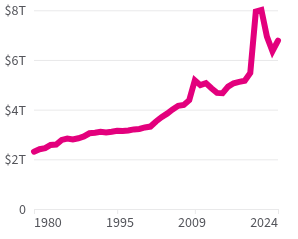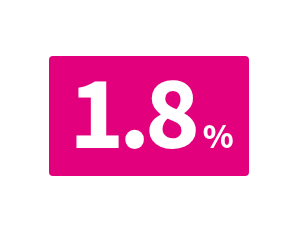Everything you need to know about a government shutdown
The impacts of government shutdowns include furloughed employees, reductions in services, closed parks and museums, and much more.
A shutdown of the United States government affects people, government agencies, and businesses not just here, but worldwide.
Here are the answers to some of Americans’ most-asked questions about a government shutdown:
What is a government shutdown?
A government shutdown occurs when Congress fails to pass or the president refuses to sign a spending bill to fund the federal government’s operations. This results in a funding gap that can cause several government functions to be temporarily disrupted. Government shutdowns are often resolved by Congress passing continuing resolutions, which provide short-term funding while negotiations for a long-term solution continue. Every shutdown since 1990 has been ended with a continuing resolution.
When was the last government shutdown?
The US government shut down on October 1, 2025, and reopened on November 12, 2025. Prior to the 2025 shutdown, the government last shut down in 2019. According to statements by President Trump, the 2019 shutdown was partially due to disputes over the US–Mexico border wall.
How long did the 2025 shutdown last?
The 2025 government shutdown lasted for 43 days, from October 1, 2025, to November 12, 2025, making it the longest shutdown in US history.
The government shutdown in 2025 was the longest in US history.
Duration of federal government funding gaps in days since 1977
How many times has the government shut down?
The current budget process was established in 1976. Since then, the government has had 21 funding gaps, resulting in 11 shutdowns for various lengths of time.
Before the 1980s, funding gaps did not usually result in government shutdowns. Agencies would continue to operate with the expectation that funding would resume in the future. But since 1982, shortly after the basis for government shutdowns was established, funding gaps have led to full or partial shutdowns more frequently.

What happens during a government shutdown?
A government shutdown leads to the temporary closure or reduced operation of non-essential government services. Some federal employees may be furloughed or temporarily laid off, while essential employees continue to work without pay.
Who is affected?
A shutdown primarily affects non-essential federal employees, as well as people and businesses that rely on government services. Many non-essential government employees are temporarily furloughed during a shutdown, while essential personnel whose funding is not dependent on annual appropriations bills – such as military service members, law enforcement agents, and air traffic controllers – continue to work.
Federal employees classified as “excepted” are in roles whose funding is dependent on appropriations bills but who are still required to work during a shutdown. Agencies are legally required to compensate these employees for their work during a shutdown, even if funding is not immediately available to pay them during the shutdown.

What is a furlough?
A furlough is a mandatory temporary unpaid leave of absence for employees, typically due to a lack of funding. Non-essential federal employees are furloughed during government shutdowns until Congress approves funding to resume operations. Furloughed federal employees generally receive back pay when the shutdown ends.
Furlough vs. Reduction in Force (RIF)
A furlough is different from federal layoffs, officially called a “Reduction in Force” (RIF). The Office of Personnel Management sets the rules for how agencies must carry out force reduction. In this process, agencies determine which employees can remain in their current positions and whether others have rights to different positions. Agencies must follow four retention factors when making these decisions:
• An employee’s tenure (type of appointment)
• Veterans’ preference
• Length of service
• Performance ratings
What services are impacted by a government shutdown?
The specific agencies and services affected by a government shutdown depend on the details of the funding legislation in effect at the time of the shutdown. Past shutdowns have affected numerous services and agencies, including:
- National parks and monuments
- Federal museums
- Federal research projects
- Processing of certain government benefits
- IRS taxpayer services
What services are not affected?
Many essential government services continue to operate during a shutdown, either because they are excepted from furloughs to ensure public safety and welfare or are funded outside of annual appropriations (such as mandatory spending programs or self-funded programs). These include:
- Social Security and Medicare benefits
- The military and federal law enforcement
- US Postal Service
- Air traffic control
- US Passport Agency
How does the government decide which departments and employees are essential?
Essential activities and personnel can continue certain functions if they are
- Authorized by law (like social security payments)
- Necessary to protect life or property (like law enforcement, medical care, air traffic control, SNAP benefits)
- Necessary to facilitate an orderly shutdown of the government (like issuing furlough notices).
Frequently asked questions about government shutdowns
Are national parks and museums open during a shutdown?
Depending on available funding and staffing, national parks and museums may close or continue to operate but with limited services. National parks that remain open may have reduced or no visitor services. For updated information on specific park closures or limitations, visit the National Park Service (NPS) website.
Do VA payments continue during a government shutdown?
Government shutdowns don’t affect Veteran Affairs benefits such as compensation, pension, education, and housing. However, other VA services may be reduced, and offices may be closed. For more information, visit the VA’s shutdown contingency plan.
Are passports or travel affected by a shutdown?
Passport services are not expected to be affected by a government shutdown, although it depends on the length of the shutdown and the location of the passport office. Transportation Security Administration, Customs and Border Protection, and air traffic control workers are considered essential and would work without pay.
For updates on passport services, visit the Department of State’s US Passports News . For travel updates, visit the TSA website.
Are Social Security benefits paid during a shutdown?
Social Security benefits will continue to be paid during a government shutdown. According to the Social Security Administration’s contingency plan, essential services, including processing benefit payments, continue even during a shutdown. However, some administrative operations not critical to direct service may be delayed.
Does Medicare and Medicaid coverage continue during a shutdown?
Medicare and Medicaid coverage continues and reimbursements will still be processed. The Department of Health and Human Services says it will continue operations for mandatory healthcare program payments with a limited staff. For more information, visit the HHS contingency plan.
What happens to SNAP benefits during a shutdown?
The Supplemental Nutrition Assistance Program (SNAP) and the Special Supplemental Nutrition Program for Women, Infants, and Children (WIC) may be impacted, depending on the duration of the shutdown.
SNAP is considered an essential program, but its funding relies on annual budgets. Without a budget or a continuing resolution, funds may run out.
Because WIC doesn’t have permanent funding authority, the USDA and Food Nutrition Service will provide funding as long as possible, and rely on states for additional funding. But without continued federal funding, benefits could be delayed, reduced, or stopped.
Do you have to pay taxes while the government is shut down?
Yes, paying taxes is still required during a government shutdown. The IRS typically continues to process tax returns and payments. However, certain services, such as issuing tax refunds or conducting audits, may be delayed. For information on operations during a shutdown, visit the IRS’s contingency plan.
How do taxes fund the government?
Does the president get paid?
Yes, the president continues to get paid during a government shutdown. Article II, Section 1 of the Constitution states that the president’s salary may not be reduced while in office, meaning that their pay cannot be withheld. It’s considered mandatory spending.
Do Congresspeople and Senators get paid?
Yes — members of Congress (both Representatives and Senators) continue to receive their pay during a government shutdown. Congressional salaries are required by the US Constitution and part of mandatory spending, not the annual appropriations bills that can lapse during a shutdown. That means their pay is not directly affected by the funding gap.
What happens to Pell Grants and other federal grants during a shutdown?
The disbursement of Pell Grants and other federal educational grants continues as usual because their funds are appropriated a year in advance. However, some administrative tasks may be delayed. For more details, refer to the Department of Education’s contingency plan.
Are post offices open during a government shutdown? Does mail still get delivered?
Yes, post offices remain open and mail delivery continues during a government shutdown. The Postal Service (USPS) operates independently from the federal government and generates its own revenue, so it is not directly affected by a shutdown. For more information, visit the most recent USPS shutdown contingency plan.
Will you receive unemployment benefits during a shutdown?
Unemployment benefits are generally not affected by a government shutdown. State unemployment insurance benefits also continue as the funding for these programs comes from state sources. For more information about unemployment benefits, contact your state's unemployment insurance office.

Are FHA loans affected by a government shutdown?
During a government shutdown, processing Federal Housing Administration (FHA) loans may be delayed due to reduced staffing. However, the Department of Housing and Urban Development (HUD), which oversees the FHA, maintains a limited staff to continue loan processing and other critical functions. For more information, refer to HUD’s shutdown FAQs.
Is student financial aid affected by a government shutdown?
Similar to Pell Grants, most federal student aid funds are funded in advance and not directly affected by a government shutdown. Financial aid disbursement generally continues as usual. However, some administrative tasks might be delayed. Refer to the Department of Education’s contingency plan for more details.
See more data on the federal budget and get more data directly in your inbox by subscribing to our weekly newsletter.
Keep exploring
Page sources
US House of Representatives
Funding Gaps and Shutdowns in the Federal Government
The White House
Agency Contingency Plans

